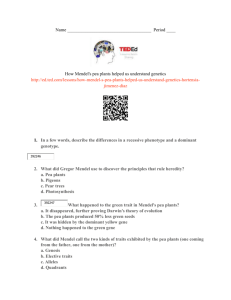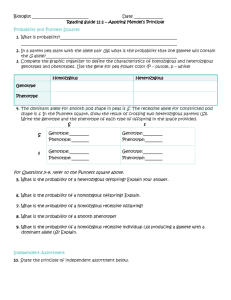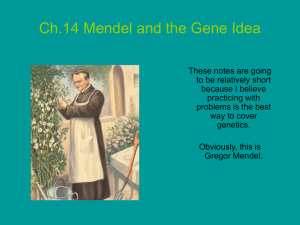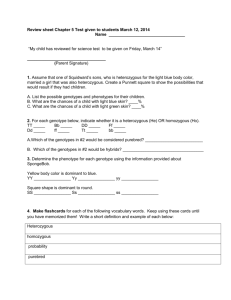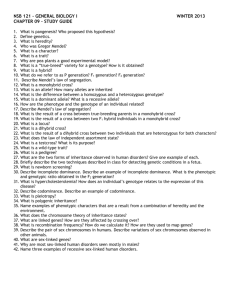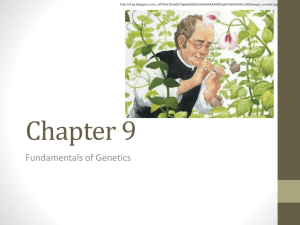Chapter 9--Fundamentals of Genetics
advertisement
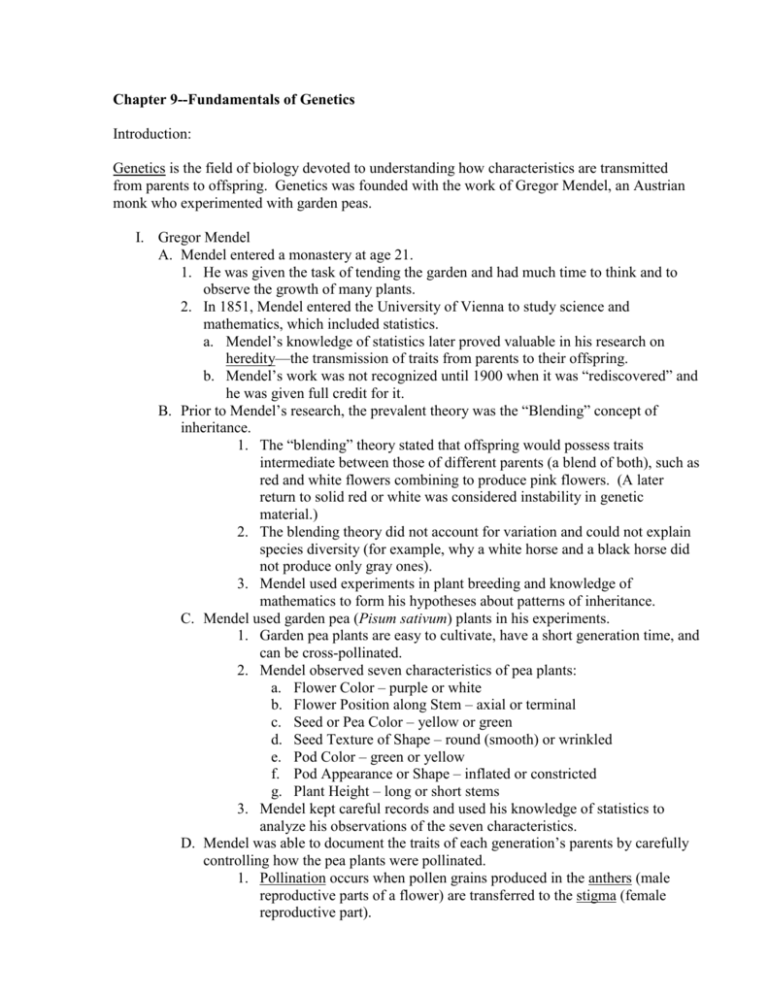
Chapter 9--Fundamentals of Genetics Introduction: Genetics is the field of biology devoted to understanding how characteristics are transmitted from parents to offspring. Genetics was founded with the work of Gregor Mendel, an Austrian monk who experimented with garden peas. I. Gregor Mendel A. Mendel entered a monastery at age 21. 1. He was given the task of tending the garden and had much time to think and to observe the growth of many plants. 2. In 1851, Mendel entered the University of Vienna to study science and mathematics, which included statistics. a. Mendel’s knowledge of statistics later proved valuable in his research on heredity—the transmission of traits from parents to their offspring. b. Mendel’s work was not recognized until 1900 when it was “rediscovered” and he was given full credit for it. B. Prior to Mendel’s research, the prevalent theory was the “Blending” concept of inheritance. 1. The “blending” theory stated that offspring would possess traits intermediate between those of different parents (a blend of both), such as red and white flowers combining to produce pink flowers. (A later return to solid red or white was considered instability in genetic material.) 2. The blending theory did not account for variation and could not explain species diversity (for example, why a white horse and a black horse did not produce only gray ones). 3. Mendel used experiments in plant breeding and knowledge of mathematics to form his hypotheses about patterns of inheritance. C. Mendel used garden pea (Pisum sativum) plants in his experiments. 1. Garden pea plants are easy to cultivate, have a short generation time, and can be cross-pollinated. 2. Mendel observed seven characteristics of pea plants: a. Flower Color – purple or white b. Flower Position along Stem – axial or terminal c. Seed or Pea Color – yellow or green d. Seed Texture of Shape – round (smooth) or wrinkled e. Pod Color – green or yellow f. Pod Appearance or Shape – inflated or constricted g. Plant Height – long or short stems 3. Mendel kept careful records and used his knowledge of statistics to analyze his observations of the seven characteristics. D. Mendel was able to document the traits of each generation’s parents by carefully controlling how the pea plants were pollinated. 1. Pollination occurs when pollen grains produced in the anthers (male reproductive parts of a flower) are transferred to the stigma (female reproductive part). 2. Self-pollination occurs when pollen is transferred from the anthers of a flower to the stigma of the same flower (or another flower on the same plant). **Pea plants normally reproduce through self-pollination. 3. Cross-pollination occurs when pollen from one plant is transferred to the stigma of another plant. a. Mendel was able to interrupt self-pollination and perform crosspollination by removing the anthers from a flower from one plant and manually transferring the anther (with the pollen) to the stigma of a flower on another plant. b. By manipulating pollination, Mendel was able to protect his flowers from receiving any other pollen (transferred by wind or insects), giving him more control over the pollination of his pea plants. E. Mendel studied each characteristic and its contrasting traits individually, beginning by growing plants that were pure for each trait. 1. A trait is a category within which alternate characteristics (such as height and eye color) can be observed. 2. A hybrid is the product of parent organisms that are “true-breeding” or pure-breeding for different forms of one trait. 3. Plants that are PURE for a trait always produce offspring with that trait. 4. The term STRAIN denotes plants that a pure for a specific trait. a. Mendel produced strains by allowing the plants to self-pollinate for several generations. 1. He eventually obtained 14 strains, one for each of the 14 traits he observed. 2. He called each strain a Parental Generation or P1 Generation (parental generation in a breeding experiment). b. Mendel used cross-pollination between two strains and tracked each trait through two generations. 1. F1 generation is the first-generation offspring in a breeding experiment (the first filial generation). 2. F2 generation is the second-generation offspring in a breeding experiment (the second filial generation). F. Mendel’s results were contrary to those predicted by a blending theory of inheritance. 1. Whenever Mendel crossed strains, one of the P1 (parent) traits failed to appear in the F1 plants. In every case, that trait reappeared in a ratio of 3:1 in the F2 generation. (Ex. P1: green pod x yellow pod; F1: all green pod; F2: 3 green pod and 1 yellow pod) a. The F1 plants resembled only one of the parents. b. Characteristics of the other parent (P1) reappeared in about ¼ of the F2 plants; ¾ of the offspring resembled the F1 generation plants. 2. Mendel’s observations led him to hypothesize that something within the pea plants controlled the characteristics he observed; he called these controls factors. a. The dominant factor was so called because it masked, or dominated, the other factor for a specific trait. b. The recessive factor controlled the trait that did not appear in the F1 generation but reappeared in the F2 generation. c. The Law of Segregation is Mendel’s conclusion that paired factors segregate (separate) during the formation of reproductive cells, so that each gamete receives only one factor of each pair. d. Mendel’s Law of Independent Assortment states that factors for different characteristics are distributed to gametes independently (reshuffling of factors explains variations and why offspring differ from their parents). G. Most of Mendel’s findings agree with what biologists now know about molecular genetics—the study of the structure and function of chromosomes and genes. 1. A gene is a segment of DNA on a chromosome that controls a particular hereditary trait. Because chromosomes occur in pairs, genes also occur in pairs. 2. An allele is an alternative form of a gene (Mendel’s factors are now called alleles). a. Capital letters refer to a dominant allele that masks or hides expression of a recessive allele. b. Lowercase letters refer to a recessive allele whose expression is masked by a dominant allele. II. Genetic Crosses A. Genotype and Phenotype 1. The genetic makeup of an organism is its genotype. The genotype consists of the alleles that the organism inherits from its parents. 2. Pea plant flower color could be PP, Pp, or pp. The P allele is the dominant allele and represents purple flowers (PP or Pp). The p allele is the recessive allele. Two recessive alleles (pp) give white flowers. 3. The physical appearance of an organism as a result of its genotype is the phenotype. a. The phenotype of a PP or Pp pea plant is purple flowers. b. The phenotype of a pp pea plant is white flowers. 4. When both alleles of a pair are alike, the organism is said to be homozygous for that characteristic. An organism may be homozygous dominant (ex. genotype PP) or homozygous recessive (ex. genotype pp). 5. When both alleles of a pair are different, the organism is heterozygous (genotype Pp) for that characteristic. B. Probability 1. Probability is the likelihood that a specific event will occur or is the likely outcome a given event will occur from random chance. 2. A probability may be expressed as a decimal (0.75), a percentage (75%) or a fraction (3/4). 3. Probability is determined by the following equation: PROBABILITY = Number of times an event is expected to happen Number of opportunities for an event to happen 4. The results predicted by probability are more likely to occur when there are many trials. C. Predicting Results of Monohybrid Crosses 1. A cross between individuals that involves one pair of contrasting traits is called a monohybrid cross. a. A cross between a pea plant that is pure for producing purple flowers (genotype PP) and one that is pure for producing white flowers (genotype pp) is an example of a monohybrid cross. b. Biologists use a diagram called a Punnett square to aid in predicting the probability that certain traits will be inherited by offspring. 1. This tool provides a simple method to calculate probable results of a genetic cross. 2. In a Punnett square, all possible types of sperm alleles are lined up vertically, and all possible egg alleles are lined up horizontally; every possible combination is placed in the squares. **In this example, both parents are heterozygous for yellowpea allele (Yy). Y y Y YY Yy y Yy yy 2. Examples of monohybrid crosses: a. HOMOZYGOUS X HOMOZYGOUS P P p Pp Pp p Pp Pp The combination of PP and pp alleles in the Punnett square indicates all the possible genotypes that can result from the cross. The predicted genotype is Pp in every case. There is a 100% probability that the offspring will have the genotype Pp (heterozygous dominant) and the phenotype purple flower color. b. HOMOZYGOUS X HETEROZYGOUS B B BB b Bb B BB Bb The predicted genotype BB is 2/4 or 50% and the genotype Bb is 2/4 or 50%. There is a 50% probability that the offspring will have the genotype BB (homozygous dominant) and the phenotype black. There is a 50% probability that the offspring will have the genotype Bb (heterozygous dominant) and the phenotype black. The probability of the phenotype of black coat in every case is 4/4 or 100%. c. HETEROZYGOUS X HETEROZYGOUS B = Dominant Black b = Recessive Brown B B BB b Bb b Bb bb The predicted genotype BB is ¼ or 25%, the genotype Bb is 2/4 (1/2) or 50%, and the genotype bb is ¼ or 25%. ¾ or 75% of the offspring from this cross are predicted to have a black coat, and ¼ or 25% of the offspring are predicted to have a brown coat. *The ratio of the genotypes that appear in offspring is called the genotypic ratio. The ratio of the phenotypes that appear in offspring is called the phenotypic ratio. d. TESTCROSS 1. A testcross is used to determine the genotype of an unknown individual. 2. A testcross is performed by crossing an individual of unknown genotype with a known homozygous recessive (bb) individual. 3. A testcross can determine the genotype of any individual whose phenotype is dominant (BB or Bb). e. INCOMPLETE DOMINANCE 1. When one allele had complete dominance over another, this relationship is called complete dominance. 2. When complete dominance is expressed, heterozygous plants (PP) and dominant homozygous plants (Pp) are indistinguishable in phenotype. Both pea plants have purple flowers. 3. Sometimes, the F1 offspring will have a phenotype “inbetween” that of the parents, a relationship called incomplete dominance. 4. Incomplete dominance occurs when two or more alleles influence the phenotype, resulting in a phenotype intermediate between the dominant trait and recessive trait. 5. In four o’clocks (a plant) both the allele for red flowers (R ) and the allele for white flowers (r) influence the phenotype. 6. Neither allele is completely dominant over the other allele. 7. When four o’clocks self-pollinate, red flowering plants produce only red flowering offspring, and white flowering plants only produce white flowering offspring. 8. However, when red four o’clocks are crossed with white four o’clocks, the F1 offspring all have pink flowers. 100% of the offspring of this cross have the Rr genotype, which results in the pink phenotype. f. CODOMINANCE 1. Codominance occurs when both alleles for a gene are expressed in a heterozygous offspring. 2. In codominance, neither allele is dominant or recessive, nor do alleles blend in the phenotype. 3. A capital letter is used for one allele (R ), the other allele is a capital letter and apostrophe (R’), giving the genotype RR’. D. Predicting Results of Dihybrid Crosses 1. A dihybrid cross is a cross between individuals that involves TWO pairs of contrasting traits. 2. Predicting the results of a dihybrid cross is more complicated that predicting the results of a monohybrid cross because there are more possible combinations. Example 1: HOMOZYGOUS X HOMOZYGOUS R = Dominant Round, r = Recessive Wrinkled Y = Dominant Yellow, y = Recessive Green Parent rryy crossed with Parent RRYY ry ry ry ry RY RrYy RrYy RrYy RrYy RY RrYy RrYy RrYy RrYy RY RrYy RrYy RrYy RrYy RY RrYy RrYy RrYy RrYy a. This Punnett square is used to predict the results of a cross between a pea plant that is homozygous for round, yellow seeds (RRYY) and one that is homozygous for wrinkled, green seeds (rryy). b. The genotype for all the offspring of this cross will be heterozygous for both traits, RrYy, and the phenotype of all the offspring will be round and yellow seeds. Example 2: HETEROZYGOUS X HETEROZYGOUS R = Dominant Round, r = Recessive Wrinkled Y = Dominant Yellow, y = Recessive Green Parent RrYy crossed with Parent RrYy RY RY Ry rY ry RRYY RRYy RrYY RrYy Ry RRYy RRyy RrYy Rryy rY RrYY RrYy rrYY rrYy ry RrYy Rryy rrYy rryy a. This Punnett square is used to predict the results of a cross between two pea plants heterozygous for round and yellow seeds, genotype RrYy. b. The games for both parents will be RY, Ry, rY, ry. c. The offspring of this dihybrid cross will have nine different genotypes with the following four phenotypes: 1. 9/16 with round, yellow seeds (genotypes RRYY, RRYy, RrYY, and RrYy 2. 3/16 with round, green seeds (genotypes RRyy, Rryy) 3. 3/16 with wrinkled, yellow seeds (genotypes rrYy and rrYy) 4. 1/16 with wrinkled, green seeds (genotype rryy) d. A phenotypic ratio of 9:3:3:1 is expected when individuals heterozygous for two traits are crossed.

